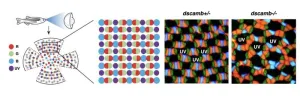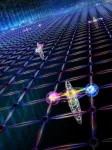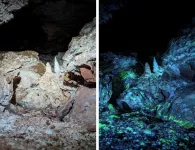(Press-News.org) Along with nitrogen and carbon, phosphorus is an essential element for life on Earth. It is a central component of molecules such as DNA and RNA, which serve to transmit and store genetic information, and ATP (adenosine triphosphate), which cells need to produce energy.
Phosphorus may also have played a key role in the origin of life. Certain conditions are needed to trigger the start of the biochemical processes that precede life. One of these is the presence of sufficient phosphorus. Its availability regulates the growth and activities of organisms. Unlike nitrogen or carbon, however, phosphorus is relatively rare at Earth's surface – which was the case in the era before life existed as well as today.
It is precisely because phosphorus is rare and so difficult to obtain, yet subject to high demand by living organisms, that scientists have long wondered how life could have arisen at all.
To answer this question, they conducted experiments in the laboratory. These showed that prebiotic chemistry requires very high concentrations of phosphorus – about 10,000 times more phosphorus than naturally occurs in water. This raises the question of how and where such high concentrations of phosphorus in water occurred on Earth billions of years ago.
Earth scientist Craig Walton has a new answer: large soda lakes without natural runoff could maintain phosphorus concentrations for a sufficiently long time, even if life begins to exist in them at some point (and continuously consumes phosphorus). The results of the study have just been published in the journal Science Advances.
Such lakes lose water only through evaporation. This means that phosphorus is left in the water instead of being washed away through rivers and streams. As a result, very high concentrations of phosphorus can build up in these soda lakes.
As early as 2020, researchers from the University of Washington had suggested that soda lakes could be the cradle of life. Walton has now taken this further. The researcher is investigating questions about the origin of life from a geochemical perspective as part of a Nomis fellowship at ETH Zurich’s Centre for Origin and Prevalence of Life (COPL).
Not every soda lake is suitable; Walton excludes small ones. “As soon as life develops in them, their phosphorus supply would be depleted faster than it is replenished. This would nip in the bud both the chemical reactions and the developing life,” says Walton. In large soda lakes, on the other hand, the phosphorus concentrations are high enough to sustain both the basic chemical reactions and life over the long term. These high concentrations are achieved through a high volume of inflowing river water, which contains phosphorus, while water only leaves the lake through evaporation. Since phosphorus does not evaporate easily, it stays behind and accumulates in the lake.
One example of such a large soda lake is Mono Lake in California. It is about twice the size of Lake Zurich. In Mono Lake, the phosphorus concentration remains constantly high, allowing a wide variety of organisms to flourish. This is crucial because in small lakes, the phosphorus is used up before new amounts can be formed. Phosphorus in Mono Lake is therefore maintained at a high concentration, which means that a lot of phosphorus regularly flows in without the phosphorus content dropping too quickly.
Walton and his team therefore consider large soda lakes that had a constant high phosphorus supply in the early history of the Earth to have been an ideal environment for the origin of life. The researchers assume that life is more likely to have originated in such large bodies of water than in small pools, as Charles Darwin had suspected.
The origin of life could therefore be closely linked to the special environment of large soda lakes, which, due to their geological setting and phosphorus balance, provided ideal conditions for prebiotic chemistry. “This new theory helps to solve another piece of the puzzle of the origin of life on Earth,” says Walton.
END
Were large soda lakes the cradle of life?
2025-03-25
ELSE PRESS RELEASES FROM THIS DATE:
Most in-depth simulation of brain metabolism yet reveals new targets for future dementia treatments
2025-03-25
The findings come from the most comprehensive computer model of brain metabolism to date, which incorporates more than 16,800 biochemical interactions between proteins and chemicals across brain cells, supporting cells, and the blood.
Scientists can now use this open-source model to find ways to prevent age-related diseases, such as dementia.“This study provides an x-ray view into the battery that powers the brain,” said Henry Markram, Professor of Neuroscience at École Polytechnique Fédérale de Lausanne (EPFL), Switzerland, the senior author of the study. “We can now track ...
USF study: Smartphones may benefit kids, but public social media use poses risks
2025-03-25
A full slide deck of findings is available at the Box link here
TAMPA, Fla. (March 18, 2025) – A groundbreaking new study of young people’s digital media use has revealed surprising results, including evidence that smartphone ownership may actually benefit children.
The study also suggests a link between social media posting and various negative outcomes, as well as data connecting cyberbullying to depression, anger and signs of dependence on digital media.
The Life in Media Survey, led by a team of researchers at the University of South Florida in collaboration with The Harris Poll, conducted a survey of ...
Study shows how retinal cells know when to keep their distance
2025-03-25
In vertebrate retinas, specialized photoreceptors responsible for color vision (cone cells) arrange themselves in patterns known as the “cone mosaic”. Researchers at the Okinawa Institute of Science and Technology (OIST) have discovered that a protein called Dscamb acts as a "self-avoidance enforcer" for color-detecting cells in the retinas of zebrafish, ensuring they maintain perfect spacing for optimal vision. Their findings have been published in Nature Communications.
Solving a mystery in vision science
Vertebrate retinas contain photoreceptor cells that convert light into neural signals. These photoreceptors come in two main types: rods, which function ...
New type of quantum computer studies the dance of elementary particles
2025-03-25
The standard model of particle physics is our best theory of the elementary particles and forces that make up our world: particles and antiparticles, such as electrons and positrons, are described as quantum fields. They interact through other force-fields, such as the electromagnetic force that binds charged particles.
To understand the behaviour of these quantum fields and with that our universe, researchers perform complex computer simulations of quantum field theories. Unfortunately, many of these calculations are too complicated for even our best supercomputers and pose great challenges for quantum computers as well, leaving many pressing ...
AI can help doctors give intravenous nutrition to preemies, Stanford Medicine study finds
2025-03-25
Artificial intelligence can improve intravenous nutrition for premature babies, a Stanford Medicine study has shown. The study, which will publish March 25 in Nature Medicine, is among the first to demonstrate how an AI algorithm can enable doctors to make better clinical decisions for sick newborns.
The algorithm uses information in preemies’ electronic medical records to predict which nutrients they need and in what quantities. The AI tool was trained on data from almost 80,000 past prescriptions for intravenous nutrition, which was linked to information about how the tiny patients fared.
Using AI to help prescribe IV nutrition could reduce medical errors, ...
New study uncovers key pathways in hydronium and hydroxide ion neutralization
2025-03-25
A new study provides fresh insight into traditional acid-base chemistry by revealing that the mutual neutralization of isolated hydronium (H₃O⁺) and hydroxide (OH⁻) ions is driven by electron transfer rather than the proton transfer that is expected in bulk liquid water. Using deuterated water ions and advanced 3D coincidence imaging of the neutral products, researchers found two electron-transfer mechanisms that produce hydroxyl radicals (OH), which are crucial in atmospheric chemistry. These findings reshape our understanding ...
ASM and IUMS unveil global framework to implement microbial climate solutions
2025-03-25
Washington, D.C.—As climate change continues to accelerate at an alarming pace, innovative and scalable solutions are more critical than ever. This week, the American Society for Microbiology (ASM) and the International Union for Microbiological Societies (IUMS) released Microbial Solutions for Climate Change, a report developed by their scientific advisory group (SAG) of global experts. The report outlines innovative microbial technologies that can significantly contribute to climate change mitigation and underscores the urgent need for coordinated global action across nations ...
‘Low-sugar’ vaccine can provide broad immunity against coronavirus variants
2025-03-25
SAN DIEGO, March 25, 2025 — Sugar coatings aren’t only for candies; they also help viruses, like the ones that cause COVID-19, hide from their hosts’ immune system. Now, researchers have developed a universal vaccine that targets coronaviruses and the sugars that they use as cover. As demonstrated in animal studies, the vaccine removed sugar molecules from an area of a coronavirus spike protein that rarely mutates and created effective and plentiful antibodies to inactivate the virus.
Chi-Huey Wong, a chemistry professor ...
Chewing gum can shed microplastics into saliva, pilot study finds
2025-03-25
SAN DIEGO, March 25, 2025 — Plastic is everywhere. And many products we use in everyday life, such as cutting boards, clothes and cleaning sponges, can expose people to tiny, micrometer-wide plastic particles called microplastics. Now, chewing gum could be added to the list. In a pilot study, researchers found that chewing gum can release hundreds to thousands of microplastics per piece into saliva and potentially be ingested.
The researchers will present their results at the spring meeting of the American Chemical ...
Fluorescent caves could explain how life persists in extraterrestrial environments
2025-03-25
SAN DIEGO, March 25, 2025 — Deep below Earth’s surface, rock and mineral formations lay hidden with a secret brilliance. Under a black light, the chemicals fossilized within shine in brilliant hues of pink, blue and green. Scientists are using these fluorescent features to understand how the caves formed and how life is supported in extreme environments, which may reveal how life could persist in faraway places, like Jupiter’s icy moon Europa.
The researchers will present their results at the spring meeting of the American Chemical Society (ACS). ACS Spring 2025 is being held March 23-27; it features about 12,000 presentations on ...





